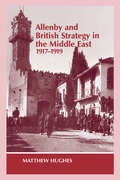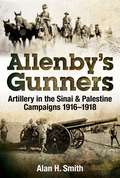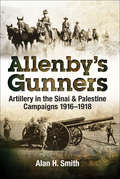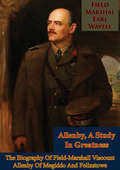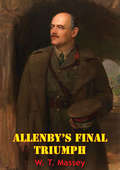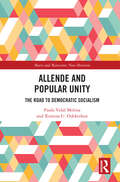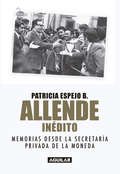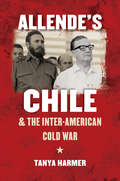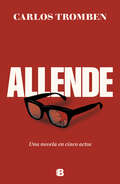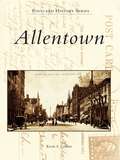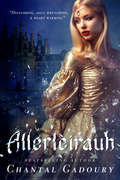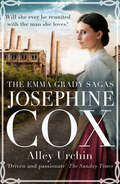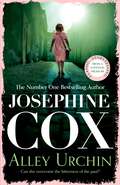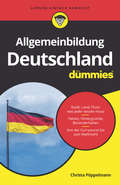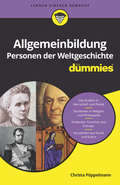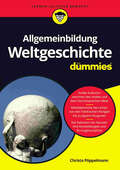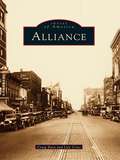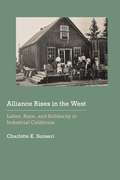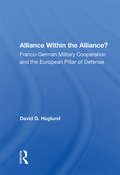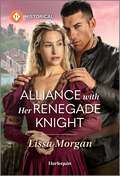- Table View
- List View
Allenby and British Strategy in the Middle East, 1917-1919 (Military History and Policy #No. 1)
by Matthew HughesExamines British military, political and imperial strategy in the Middle East during and immediately after the First World War, in relation to General Allenby's command of the Egypt Expeditionary Force from June 1917 to November 1919.
Allenby's Gunners: Artillery in the Sinai & Palestine Campaigns 1916-1918
by Alan H. SmithAlan Smith&’s Allenby&’s Gunners tells the story of artillery in the highly successful World War I Sinai and Palestine campaigns. Following Gallipoli and the reconstitution of the AIF, a shortage of Australian gunners saw British Territorial artillery allotted to the Australian Light Horse and New Zealand Mounted Rifle brigades. It was a relationship that would prove highly successful and &‘Allenby&’s Gunners&’ provides a detailed and colourful description of the artillery war, cavalry and infantry operations from the first battles of Romani and Rafa, through the tough actions at Gaza, the Palestine desert, Jordan Valley and Amman to the capture of Jerusalem. The story concludes with the superb victory at Megiddo and the taking of Damascus until the theatre armistice of October 1918. Smith covers the trials and triumphs of the gunners as they honed their art in one of the most difficult battlefield environments of the war. The desert proved hostile and unrelenting, testing the gunners, their weapons and their animals in the harsh conditions. The gunners&’ adversary, the wily and skilful Ottoman artillerymen, endured the same horrendous conditions and proved a tough and courageous foe. The light horsemen and gunners also owed much to the intrepid airmen of the AFC and RFC whose tactical and offensive bombing and counter-battery work from mid-1917 would prove instrumental in securing victory. This is an aspect of the campaign that is seamlessly woven throughout as the action unfolds. The Sinai and Palestine campaigns generally followed a pattern of heavy losses and setbacks for an initial period before Allied forces eventually prevailed. This is a highly descriptive volume that tells an oft-neglected story and fills a gap in the record of a campaign in which Australians played a significant role. It is a welcome addition to the story of the Australians in the Middle Eastern campaigns of World War I.
Allenby's Gunners: Artillery in the Sinai & Palestine Camptaings, 1916–1918
by Alan H. SmithAlan Smith's Allenby's Gunners tells the story of artillery in the highly successful World War I Sinai and Palestine campaigns. Following Gallipoli and the reconstitution of the AIF, a shortage of Australian gunners saw British Territorial artillery allotted to the Australian Light Horse and New Zealand Mounted Rifle brigades. It was a relationship that would prove highly successful and Allenby's Gunners provides a detailed and colorful description of the artillery war, cavalry and infantry operations from the first battles of Romani and Rafa, through the tough actions of Gaza, the Palestine desert, Jordan Valley and Amman to the capture of Jerusalem. The story concludes with the superb victory of Megiddo and the taking of Damascus until the theater armistice of 1918.Smith Covers the trials and triumphs of the gunners as they honed their art in one of the most difficult battlefield environments of the war. The desert proved hostile and unrelenting, testing the gunners, their weapons and their animals in the harsh conditions. The gunners' adversary, the wily and skillful Ottoman artillerymen, endured the same horrendous conditions and proved a tough and courageous foe.The light horsemen and gunners also owed much to the intrepid airmen of the AFC and RFC whose tactical and offensive bombing and counter-battery work from mid-1917 would prove instrumental in securing victory. This is an aspect of the campaign that is seamlessly woven throughout as the action unfolds.The Sinai and Palestine campaigns generally followed a pattern of heavy losses and setbacks for an initial period before allied forces eventually prevailed. This is a highly descriptive volume that tells and oft-neglected story and fills the gap in the record of a campaign in which Australians played a significant role. It is a welcome addition to the story of the Australians in the Middle Eastern campaigns of World War I.
Allenby, A Study In Greatness: Allenby In Egypt (Allenby, A Study In Greatness #2)
by Field-Marshal Earl WavellIn this two-part biography, Field Marshal Wavell, charts the rise of the 1st Viscount Allenby, from a lowly cavalry lieutenant to the rank of Field Marshal.Allenby was commissioned into the 6th Dragoons in 1880, well-liked by his contemporaries but never considered overly talented. However under fire and in contact with the enemy during the Boer War, Allenby's talents began to come to the fore; tough and disciplined, he was rapidly promoted with each battlefield success. Afflicted by a rabid temper, which led to towering rages at subordinates, he was nicknamed "The Bull".When Europe descended into chaos and the horrors of the First World War in 1914, Allenby was given command of the only British cavalry brigade to be sent to France in 1914. The cavalry distinguished itself in the chaotic fighting of 1914, particularly at the First Battle of Ypres. As trench warfare removed any possibility of a war of movement, Allenby transferred to command of V Corps and then to lead Third Army. Allenby's tactics including frequent counterattacks led to heavy casualties would lead to his transfer to Egypt. Allenby organised, planned and executed the campaign across Egypt and the Palestine that threw the Ottoman army back all the way Aleppo before the armistice in 1918. Allenby would stay on in Egypt as High Commissioner between 1919-1925, dealing with the fluid and tricky politics of the area before his eventual retirement."Here is a piece of work well done and apt reading for the times. General Wavell is at once the pupil and successor of his great Palestine commander, and is qualified also by sobriety, detachment of view, and a gift of clear, concise writing. Three factors have combined...the skill of the very competent biographer; the crescendo of interest, culminating in one of the most brilliantly conceived victories in history, and, last and most, the rugged splendour of Allenby's character."--SIR RONALD STORRS, in The Spectator.
Allenby, A Study In Greatness: The Biography Of Field-Marshall Viscount Allenby Of Megiddo And Felixstowe (Allenby, A Study In Greatness #1)
by Field-Marshal Earl WavellIn this two-part biography, Field Marshal Wavell, charts the rise of the 1st Viscount Allenby, from a lowly cavalry lieutenant to the rank of Field Marshal.Allenby was commissioned into the 6th Dragoons in 1880, well-liked by his contemporaries but never considered overly talented. However under fire and in contact with the enemy during the Boer War, Allenby's talents began to come to the fore; tough and disciplined, he was rapidly promoted with each battlefield success. Afflicted by a rabid temper, which led to towering rages at subordinates, he was nicknamed "The Bull".When Europe descended into chaos and the horrors of the First World War in 1914, Allenby was given command of the only British cavalry brigade to be sent to France in 1914. The cavalry distinguished itself in the chaotic fighting of 1914, particularly at the First Battle of Ypres. As trench warfare removed any possibility of a war of movement, Allenby transferred to command of V Corps and then to lead Third Army. Allenby's tactics including frequent counterattacks led to heavy casualties would lead to his transfer to Egypt. Allenby organised, planned and executed the campaign across Egypt and the Palestine that threw the Ottoman army back all the way Aleppo before the armistice in 1918. Allenby would stay on in Egypt as High Commissioner between 1919-1925, dealing with the fluid and tricky politics of the area before his eventual retirement."Here is a piece of work well done and apt reading for the times. General Wavell is at once the pupil and successor of his great Palestine commander, and is qualified also by sobriety, detachment of view, and a gift of clear, concise writing. Three factors have combined...the skill of the very competent biographer; the crescendo of interest, culminating in one of the most brilliantly conceived victories in history, and, last and most, the rugged splendour of Allenby's character."--SIR RONALD STORRS, in The Spectator.
Allenby’s Final Triumph [Illustrated Edition]
by William Thomas MasseyIncludes the World War One In The Desert Illustration Pack- 115 photos/illustrations and 19 maps spanning the Desert campaigns 1914-1918THIS narrative, it is hoped, will serve to remove the impression which prevails among a not inconsiderable section of the British public that the Army commanded and handled with such consummate skill by Lord Allenby in Palestine had a comparatively simple task...In 1918 General Allenby had to contend with enormous difficulties. He was faced with the problem of having to arrange his operations so as to fit in with the calls made upon him to reinforce the Western Front. At a time when the Turkish moral was still good, he had to send to France the bulk of his veteran British infantry when they were in the highest state of efficiency, and, with new Indian troops in their place, he had to build up another army. In these pages I have tried to show how, while increasing the power of his fresh troops, he forced down the fighting capacity of his enemy, and then, when by a most ably worked out scheme of camouflage he had concealed scores of thousands of men and horses at the place of attack, he launched his host against an army whose moral he had reduced to a low level. By employing a magnificent body of cavalry he gave another lesson to the armies of the world in the employment of the mounted arm, and, uninfluenced by the desires of London and Paris that this or that should be his aim, his own plans, worked out in his own way, secured far more than War Councils or War Cabinets had any right to expect. The Army's appreciation of Lord Allenby is correct.
Allende and Popular Unity: The Road to Democratic Socialism (Marx and Marxisms)
by Paula Vidal Molina Ximena U. OdekerkenThis book is a fascinating collection of carefully handpicked key texts and speeches from Chile’s 1,000 Days of Revolution, previously unpublished in English. Twenty-three texts embodying the activity of Unidad Popular and Salvador Allende’s government in the early 1970s are structured around five thematic sections, which tell the story of the common challenges for progressive political organizations and social movements today. The themes of participatory democracy and sovereignty, economy and social rights, women and gender equality, indigenous people, and worker-class syndicalism and political organization guide the reader through the multidimensional and global vision of Popular Unity’s socialist project. Ideal for students, scholars, and general readers, this book introduces an extraordinary period in Chile’s history to a new generation of readers interested in the resurgence of democratic socialism around the world.
Allende inédito: Memorias de la Secretaría Privada de La Moneda
by Patricia Espejo BrainTestimonio íntimo de los tres años de la Unidad Popular contadas por la persona de confianza del presidente Allende. Patricia Espejo trabajó en el equipo más cercano y de confianza del presidente Salvador Allende durante los mil días de su gobierno. En estas, sus memorias, relata el triunfo de la Unidad Popular y su trabajo en La Moneda, donde fue testigo privilegiado de los esfuerzos para sacar adelante el proyecto de la vía chilena al socialismo, así como de las circunstancias que desembocaron en el golpe militar del 11 de septiembre de 1973. Su cercanía con Allende y la amistad con su hija Tati, le permiten hablar de él, sus cercanos y su gobierno con una mirada que lo humaniza y desmitifica. Cincuenta años después del inicio de la UP, la autora revela detalles desconocidos del primer mandatario marxista que llegaba al poder a través de las urnas. Patricia Espejo Brain nos lleva al interior del palacio de gobierno y de las residencias de Tomás Moro y El Cañaveral para conocer desde dentro momentos clave de la historia reciente del país y la relación de Allende con su círculo más cercano, así como sus propias reflexiones y su desilusión tras largos años de exilio en Cuba y Venezuela.
Allende's Chile and the Inter-American Cold War
by Tanya HarmerFidel Castro described Salvador Allende's democratic election as president of Chile in 1970 as the most important revolutionary triumph in Latin America after the Cuban revolution. Yet celebrations were short lived. In Washington, the Nixon administration vowed to destroy Allende's left-wing government while Chilean opposition forces mobilized against him. The result was a battle for Chile that ended in 1973 with a right-wing military coup and a brutal dictatorship lasting nearly twenty years. Tanya Harmer argues that this battle was part of a dynamic inter-American Cold War struggle to determine Latin America's future, shaped more by the contest between Cuba, Chile, the United States, and Brazil than by a conflict between Moscow and Washington. Drawing on firsthand interviews and recently declassified documents from archives in North America, Europe, and South America--including Chile's Foreign Ministry Archive--Harmer provides the most comprehensive account to date of Cuban involvement in Latin America in the early 1970s, Chilean foreign relations during Allende's presidency, Brazil's support for counterrevolution in the Southern Cone, and the Nixon administration's Latin American policies. The Cold War in the Americas, Harmer reveals, is best understood as a multidimensional struggle, involving peoples and ideas from across the hemisphere.
Allende. Una novela en cinco actos
by Carlos TrombenUna novela total donde el protagonista es el expresidente Salvador Allende. Cuando se cumplen los cincuenta años de la muerte de Salvador Allende y de la instalación de la dictadura de Augusto Pinochet en Chile, Ediciones B publica esta obra única, que profundiza en la dimensión humana del "compañero presidente". Un retrato de época en el que se cruzan figuras como Humberto Maturana y Michel Foucault y se da cuenta de la efervescencia política y social de aquellos años convulsos. En esta arriesgada novela, Carlos Tromben entabla un diálogo con el máximo exponente de la vía chilena al socialismo, al que permite hablar desde el más allá y analizar ese pasado donde se encontraba encerrado por sus opositores, pero, sobre todo, por sus propios compañeros. El autor no se queda solamente en los protagonistas de la Historia: a través del relato e investigación de la hija de un científico colaborador de la Unidad Popular, intenta recomponer el pasado y armarlo a partir de miles de astillas desperdigadas. Con destreza y genio, Carlos Tromben desenreda una madeja que mantendrá al lector al filo de su asiento, entrando en aspectos desconocidos de una historia que nunca se terminará de contar, donde nada es blanco ni tampoco negro.
Allentown (Postcard History Series)
by Kevin S. GildnerAllentown is many things to many different people. It is a historical city, a city of churches, a city of immigrants, and a place that values hard work, education, and recreation. This is a city with rich and unique stories to tell. Allentown captures historical stories such as the hiding of the Liberty Bell, early railroad and canal transportation, and the training of World War I ambulance drivers. Other stories include how politics influenced the building of a world-class park system. This rare collection of postcards depicts how the people of Allentown shaped the city into their idea of the American dream.
Allerleirauh: A Classic Grimm Fairy Tale Retelling
by Chantal GadouryFans of Melissa Meyer’s Heartless will adore this triumphant retelling of the classic Grimm Fairy Tale. “Allerleirauh is my new favorite read! Full of adventures, romance, and magic. You won't be disappointed when you grab a copy!” - The Book Nook Blog In the kingdom of Tranen, a king makes a promise to his dying wife that he'll only remarry a woman who possesses her golden hair. In time, the king's eyes are turned by his daughter. Realizing her father’s intentions, Princess Aurelia tries to trick him by requesting impossible gifts: dresses created by the sun, moon and stars, and a coat made of a thousand furs. But when he is successful, Aurelia sacrifices her privileged life and flees her kingdom, disguised by a cloak and a new name, Allerleirauh. She enters the safe haven of Saarland der Licht, where the handsome and gentle Prince Klaus takes her under his care. Hoping to remain undetected by her father’s courtiers, Allerleirauh remains hidden under her new identity when she finds unexpected love with Prince Klaus, even as his arranged marriage to the princess of a neighboring kingdom approaches. Risking everything, Allerleirauh must face her troubled past and her fears of the future in her journey to self-acceptance. *TW: Sexual Violence
Alley Life in Washington: Family, Community, Religion, and Folklife in the City, 1850-1970 (Blacks in the New World)
by James BorchertForgotten today, established Black communities once existed in the alleyways of Washington, D.C., even in neighborhoods as familiar as Capitol Hill and Foggy Bottom. James Borchert's study delves into the lives and folkways of the largely alley dwellers and how their communities changed from before the Civil War, to the late 1890s era when almost 20,000 people lived in alley houses, to the effects of reform and gentrification in the mid-twentieth century.
Alley Urchin (The Emma Grady Sagas)
by Josephine CoxFrom a &“born storyteller,&” a historical saga of a wrongly imprisoned woman&’s reunion with her child and the man she loves (Times & Citizen). It is 1870 and Emma Grady has spent seven years of servitude as a convict in Australia. Now, having earned her ticket-of-leave, she is held by chains of honor and friendship. Emma&’s loyalty to her kind and gentle employer Roland Thomas, and her unwillingness to desert fellow convict and beloved friend Nelly, prevent her from leaving. Yet Emma lives for the days when she will return to England, to face those who cheated and betrayed her. And to Marlow Tanner, the man she loves, and whose tragic child she lost. As Emma battles against adversity, she is unaware that in England the child she has given up for dead is being lovingly raised by Marlow&’s sister Old Sal. Will Emma ever be reunited with Marlow? And even if she finds him, will he still love her? Despite seemingly insurmountable obstacles, her love can never be denied, or forgotten. The breathtaking second novel of The Emma Grady Sagas Praise for the writing of Josephine Cox: &“Hailed quite rightly as a gifted writer in the tradition of Catherine Cookson&” —Manchester Evening News &“Cox&’s talent as a storyteller never lets you escape.&” —Daily Mail &“Driven and passionate.&” —The Sunday Times
Alley Urchin: A thrilling saga of love, resilience and revenge (Emma Grady trilogy, Book 2)
by Josephine CoxTo return to those she loves, she must also return to the past... In the second instalment of her Emma Grady trilogy, bestselling author Josephine Cox brings us Alley Urchin, a gripping saga of a woman determined to overcome the brutality of life as a convict to return to the man she loves. Perfect for fans of Kitty Neale and Rosie Goodwin.By 1870 Emma Grady has spent seven years of servitude as a convict in Australia. Emma lives for the day when she will return to England, to face those who cheated and betrayed her. And to Marlow Tanner, the man she loves - and whose tragic child she had borne and then lost.Emma struggles to make something of her life in Australia despite the sinister presence of her employer's evil son, Foster. His determination to 'have' Emma leads to dark and terrifying consequences. As Emma battles against adversity, she is unaware that in England the child she has given up for dead is being lovingly raised by Marlow's sister Old Sal, who teaches Emma's daughter Molly to be an expert pickpocket.Will Emma ever be reunited with Marlow? Even if she finds him, will he still love her? And what of the child lost to both of them? Emma is plagued with fears but her love for Marlow never weakens - and can never be forgotten... What readers are saying about Alley Urchin: 'Josephine Cox has the unique talent of writing books which provoke every emotion in the reader. This book in the Emma Grady trilogy has all this - and more. We feel for the characters as if we know them and, as with all Josephine Cox books, it is very hard to put down the book once started... You will find yourself impatient to get to the end!''Another great, thrilling book which keeps you guessing till the end. The story is well written with some great twists''Totally absorbing. Unputdownable!'
Alley Urchin: A thrilling saga of love, resilience and revenge (Emma Grady trilogy, Book 2)
by Josephine CoxTo return to those she loves, she must also return to the past... In the second instalment of her Emma Grady trilogy, bestselling author Josephine Cox brings us Alley Urchin, a gripping saga of a woman determined to overcome the brutality of life as a convict to return to the man she loves. Perfect for fans of Kitty Neale and Rosie Goodwin.By 1870 Emma Grady has spent seven years of servitude as a convict in Australia. Emma lives for the day when she will return to England, to face those who cheated and betrayed her. And to Marlow Tanner, the man she loves - and whose tragic child she had borne and then lost.Emma struggles to make something of her life in Australia despite the sinister presence of her employer's evil son, Foster. His determination to 'have' Emma leads to dark and terrifying consequences. As Emma battles against adversity, she is unaware that in England the child she has given up for dead is being lovingly raised by Marlow's sister Old Sal, who teaches Emma's daughter Molly to be an expert pickpocket.Will Emma ever be reunited with Marlow? Even if she finds him, will he still love her? And what of the child lost to both of them? Emma is plagued with fears but her love for Marlow never weakens - and can never be forgotten... What readers are saying about Alley Urchin: 'Josephine Cox has the unique talent of writing books which provoke every emotion in the reader. This book in the Emma Grady trilogy has all this - and more. We feel for the characters as if we know them and, as with all Josephine Cox books, it is very hard to put down the book once started... You will find yourself impatient to get to the end!''Another great, thrilling book which keeps you guessing till the end. The story is well written with some great twists''Totally absorbing. Unputdownable!'
Allgemeinbildung Deutschland für Dummies (Für Dummies)
by Christa PöppelmannWer hat noch nicht erlebt, dass er auf neugierige Fragen ausländischer Freunde nur äußerst vage antworten konnte oder an kniffeligen Quiz-Fragen rund um Schwarz-Rot-Gold gescheitert ist? Obwohl man glaubt, Deutschland zu kennen, entspricht das gefühlte Wissen nicht immer den Fakten. Christa Pöppelmann wirft einen genauen Blick auf das scheinbar Bekannte, fördert vielfältige Wissensschätze zu Tage und betrachtet Entwicklungen sowie Veränderungen. Das Buch behandelt ein vielfältiges Themenspektrum von der Geografie über Wirtschaft und Politik bis hin zu typisch deutscher Lebensart, den Feinheiten der Sprache und den interessantesten Orten. Auch die Themen Kultur, Mobilität und gesellschaftliche Vielfalt kommen nicht zu kurz. Das Buch liefert wertvolles Wissen, Überraschendes und Kurioses über das Land der Dichter und Denker, der Techniker und der Tüftler.
Allgemeinbildung Personen der Weltgeschichte für Dummies (Für Dummies)
by Christa PöppelmannViele berühmte Männer und Frauen haben die Geschichte geprägt. Christa Pöppelmann erweckt sie in diesem Buch zum Leben, stellt ihre berühmten Taten und Werke, ihre Bedeutung und Schattenseiten vor. Dabei blickt sie nicht nur auf Politiker und Herrscher, sondern präsentiert auch Ikonen des Widerstands, geht auf die diskrete Macht der Frauen ein, weist auf Erfinder und Entdecker, Künstler und Autoren, Religionsstifter und Philosophen hin und wagt sich an die Frage heran: Was macht Berühmtheit überhaupt aus?
Allgemeinbildung Weltgeschichte für Dummies (Für Dummies)
by Christa PöppelmannWas hat der Siebenjährige Krieg mit der Unabhängigkeit der USA zu tun und warum studierten die Japaner einst "Hollandkunde"? Was passierte in der Schlacht von Gallipoli, die für die Australier die Schrecken des Ersten Weltkriegs symbolisiert, und welch bittere Geschichte steckt hinter dem Siegeszug von Zucker und Kaffee? Bei einem spannenden Streifzug durch Zeiten und Kulturen werden Sie erleben, wie vernetzt die Welt schon seit der Jungsteinzeit war. Sattsam bekannte Ereignisse erscheinen so in ganz neuem Licht. Daneben werden Sie unter Garantie aber auch auf viel Neues stoßen.
Alliance
by Jonathan FenbyThe history of the Second World War is usually told through its decisive battles and campaigns. But behind the front lines, behind even the command centres of Allied generals and military planners, a different level of strategic thinking was going on. Throughout the war the 'Big Three' -- Churchill, Roosevelt and Stalin -- met in various permutations and locations to thrash out ways to defeat Nazi Germany -- and, just as importantly, to decide the way Europe would look after the war. This was the political rather than military struggle: a battle of wills and diplomacy between three men with vastly differing backgrounds, characters -- and agendas. Focusing on the riveting interplay between these three extraordinary personalities, Jonathan Fenby re-creates the major Allied conferences including Casablanca, Potsdam and Yalta to show exactly who bullied whom, who was really in control, and how the key decisions were taken. With his customary flair for narrative, character and telling detail, Fenby's account reveals what really went on in those smoke-filled rooms and shows how "jaw-jaw" as well as "war-war" led to Hitler's defeat and the shape of the post-war world.
Alliance (Images of America)
by Lyle Crist Craig BaraAccording to local history, General Robinson, a railroad official from Pittsburgh, Pennsylvania, named this Ohio town "Alliance" in 1850. Known for a short time as "The Crossing," Robinson believed that Alliance was a better name since the nation's two major railroads intersected here. The name stuck, and in 1854, the communities of Williamsport, Freedom, and Liberty incorporated as the town of Alliance. In 1889, the Village of Mount Union was annexed and Alliance became a city. Not only did therailroads help form our community, they established Alliance as a city of industry. Even though the town has remained relatively small, with approximately 23,000 citizens in 1990, industry has played a vital role in the development of Alliance. Many citizensattribute the strong leadership of the town's governing body to its industrial growth. This pictorial compilation documents the growth of the railroad and the stores and factories located along these railroad routes. Even today, the availabilityof trains and the intersection of key lines in Alliance is important to manufacturers.
Alliance Formation in Civil Wars
by Fotini ChristiaSome of the most brutal and long-lasting civil wars of our time involve the rapid formation and disintegration of alliances among warring groups, as well as fractionalization within them. It would be natural to suppose that warring groups form alliances based on shared identity considerations – such as Christian groups allying with Christian groups – but this is not what we see. Two groups that identify themselves as bitter foes one day, on the basis of some identity narrative, might be allies the next day and vice versa. Nor is any group, however homogeneous, safe from internal fractionalization. Rather, looking closely at the civil wars in Afghanistan and Bosnia and testing against the broader universe of fifty-three cases of multiparty civil wars, Fotini Christia finds that the relative power distribution between and within various warring groups is the primary driving force behind alliance formation, alliance changes, group splits and internal group takeovers.
Alliance Rises in the West: Labor, Race, and Solidarity in Industrial California (Historical Archaeology of the American West)
by Charlotte K. SunseriAlliance Rises in the West documents the experiences of a company town at a critical moment in the rise of working-class consciousness in nineteenth-century California. Through archaeological research Charlotte K. Sunseri overcomes the silence of the documentary record to re-examine the mining frontier at Mono Mills, a community of multiple ethnic and racial groups, predominantly Chinese immigrants and Kudzadika Paiutes. The rise of political, economic, and social alliances among workers symbolized solidarity and provided opportunity to effect change in this setting of unequal power. Urban planning and neighborhood layout depict company structures of control and surveillance, while household archaeology from ethnically distinct neighborhoods speaks to lived experiences and how working-class identities emerged to crosscut ethnic and racial divides imposed in capitalism. Mono Mills&’s Paiute and Chinese communities experienced exclusionary legislation and brutal treatment on the basis of racial prejudice but lived alongside and built community with European American laborers, managers, and merchants who were also on an economic periphery. These experiences in Mono Mills and other nineteenth-century company towns did not occur in a vacuum; capitalists&’ control and ideologies of race and class all doubled down as American workers used collective action to change the rules of the system. In this rare, in-depth perspective, close consideration of the ghost towns that dot the landscape of the West shows the haunting elements of capitalism and racial structures that characterized Gilded Age society and whose legacies endure to this day.
Alliance Within The Alliance?: Franco-german Military Cooperation And The European Pillar Of Defense
by David G. HaglundThis book is about the Franco-German military cooperation. It discusses the ending of the Cold War, the likelihood of a continuation and deepening of security cooperation between France and Germany and the impact this might have upon the transformation of the Atlantic Alliance.
Alliance with Her Renegade Knight
by Lissa MorganA high-stakes medieval romance of duty vs. desire, as the knight is torn between completing his mission and following his heart…The knight&’s target…Becomes his greatest desire!From the moment wool merchant Isolda catches sight of Sir Henry, she senses a powerful bond. But the vigilante knight is tracking down the person penning seditious poems exposing corruption…poems she secretly wrote!Henry is torn after discovering Isolda&’s hidden identity, especially as he sympathizes with her cause. When Isolda&’s apprentice is murdered, Henry joins forces with her, hiding out in his manor, where passions run high! Yet after the traumatic death of his family, Henry can&’t let Isolda breach the walls around his heart. Still, he must find a way to earn her trust—their lives depend on it!From Harlequin Historical: Your romantic escape to the past.
